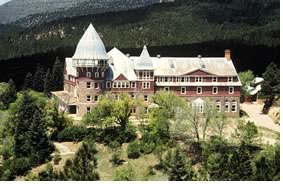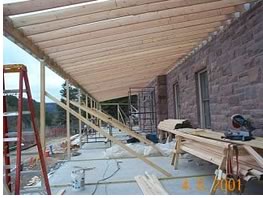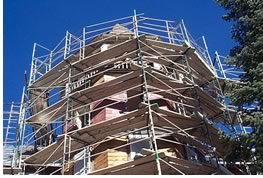
United World College to host grand reopening October 20

Managing Editor
Former Energy Secretary, U.S. Ambassador to the United Nations, and Representative from New Mexico Bill Richardson will launch the grand opening of the new Bartos Institute for the Constructive Engagement of Conflict October 20 at the Armand Hammer United World College in Montezuma, N. Mex. In its former life, the institute was none other than Montezuma Castle, Western playground for the rich and famous just before the turn of the 20th century. Einhorn Yaffee Prescott, Architect and Engineering PC, is the architectural alchemist working to give the building its new life.
Spectacular structure,
superlative setting
At the foothills of the breathtaking Sangre de Christo Mountains lies
Montezuma, N. Mex., which is just outside of Las Vegas (the other one,
in New Mexico), which is not too far from Santa Fe. Montezuma is home
to hot springs, the restorative power of which has been legend for centuries.
These famous springs led the Santa Fe Railroad to develop the area into
a resort town, the centerpiece of which was Montezuma Castle, some 90,000-square-feet
of Queen Anne confection designed by none other than Chicago's Burnham
and Root in 1884. In its heyday, the world-class resort counted among
its clientele Theodore Roosevelt, Jesse James, Ulysses S. Grant, and Japanese
Emperor Hirohito.
 The
spectacular castle, the first building in New Mexico to boast electric
lights, paid for that privilege when faulty wiring caused a fire that
burned the building to the ground in 1884. Rebuilt the following year,
it was open only for a few months before it burned to the ground again.
The third construction proved the charm: The Phoenix, as it was called,
opened in 1886. The hotel enjoyed a run of popularity for about a decade,
and then sunk into a steady decline. The railroads sold the behemoth building
to the YMCA for $1 in 1903; soon after, the Jesuits took it over as a
seminary, which it remained for almost 70 years. In 1972, however, after
years of delayed maintenance, the building was deemed too dangerous for
habitation and left empty.
The
spectacular castle, the first building in New Mexico to boast electric
lights, paid for that privilege when faulty wiring caused a fire that
burned the building to the ground in 1884. Rebuilt the following year,
it was open only for a few months before it burned to the ground again.
The third construction proved the charm: The Phoenix, as it was called,
opened in 1886. The hotel enjoyed a run of popularity for about a decade,
and then sunk into a steady decline. The railroads sold the behemoth building
to the YMCA for $1 in 1903; soon after, the Jesuits took it over as a
seminary, which it remained for almost 70 years. In 1972, however, after
years of delayed maintenance, the building was deemed too dangerous for
habitation and left empty.
In 1981, the castle ruin saw its first glimpse of redemption when international financier and philanthropist Armand Hammer bought it—and the surrounding land—to created The Armand Hammer United World College of the American West.
Help from the Trust
As the school established its footings, the castle, which had been heavily
vandalized and structurally damaged, sat as a vacant shell for years.
The privately funded college pondered its fate and an appropriate new
use-as well as how to raise the $10 million needed to restore it to former
glory. A major boost in public awareness and a boon to fundraising bloomed
when the National Trust for Historic Preservation placed the Montezuma
Castle on its "Eleven Most Endangered" list in 1997 and declared
it the first building west of the Mississippi River to be designated one
of "America's Treasures." The Trust removed it from the list
two years later when the college began its fund drive to restore the building.
 EYP
is the architect for the transformation of the castle as the heart of
the United World College's campus, as well as for preparing a campus master
plan and designing a new field house. Stabilizing the building has been
a major challenge for the architect and for contractor Bradbury Stamm
of Albuquerque. Years of neglect and piles of bat guano—not to mention
lead paint and asbestos—needed to be alleviated. The situation was
complicated by outdated structural practices as well as construction that
probably was not as sound as it should have been in the rush to rebuild
after the second fire.
EYP
is the architect for the transformation of the castle as the heart of
the United World College's campus, as well as for preparing a campus master
plan and designing a new field house. Stabilizing the building has been
a major challenge for the architect and for contractor Bradbury Stamm
of Albuquerque. Years of neglect and piles of bat guano—not to mention
lead paint and asbestos—needed to be alleviated. The situation was
complicated by outdated structural practices as well as construction that
probably was not as sound as it should have been in the rush to rebuild
after the second fire.
The structure has now been stabilized and work proceeds to fit out the interiors for EYP's new program, which includes a dining hall, classrooms, conference rooms, residential spaces, executive offices, and recreational space. Its grand south-facing veranda, removed because of deterioration during its Jesuit era, has been completely restored, as have its stained glass windows and turreted towers. The castle will in fact contain many of its old touches of grandeur, including its magnificent carved ash-ceilinged entranceway, and some new, such as eight-foot-high glass chandeliers by noted glass artist Dale Chihuly. The chandeliers will grace EYP's piece de resistance, the restored grand dining room. Its 60-foot trusses, reinforced with steel, are column-free once more. The grand room will be part of the Bartos Institute for Constructive Engagement, a center devoted to international conflict resolution.
 Hope
for the future
Hope
for the future
The newly restored dining room as a setting in which conflict can begin
to be resolved is a fitting use for the United World Colleges, which make
for an interesting story in themselves. The first, Atlantic College in
Wales, was founded in 1962 "to create a school where the youth of
the world could unite, to gain a knowledge and understanding of a variety
of races and cultures." Earl Mountbatten of Burma served as the founding
president of the International Council of the United World Colleges, later
succeeded by HRH Prince Charles. (The current president is Queen Noor
of Jordan [BA in architecture, Princeton, 1974] and the president of the
UWC International Council is Nelson Mandela.)
The Armand Hammer College, named after its founding international industrialist, joined the group in 1981. Today there are eight other United World Colleges, in Canada, Italy, Swaziland, Singapore, Venezuela, Hong Kong, Norway, and India.
Most of the colleges host 200 students, aged 16-19, who earn international baccalaureate degrees, an internationally recognized pre-university degree. UWC students are chosen on merit, regardless of race, creed, color, background or financial ability, and the majority are awarded scholarships. Service to the community is an integral part of the schools' culture.
It appears that the school is eager to show off its new masterpiece as it prepares to host tours of the college and campus grounds and this piece of history reopens to the public October 20. For more information, visit www.uwc-usa.org, or call 505-454-4200.
Copyright 2001 The American Institute of Architects. All rights reserved.
![]()
|
Photos courtesy of the United World College. |
|